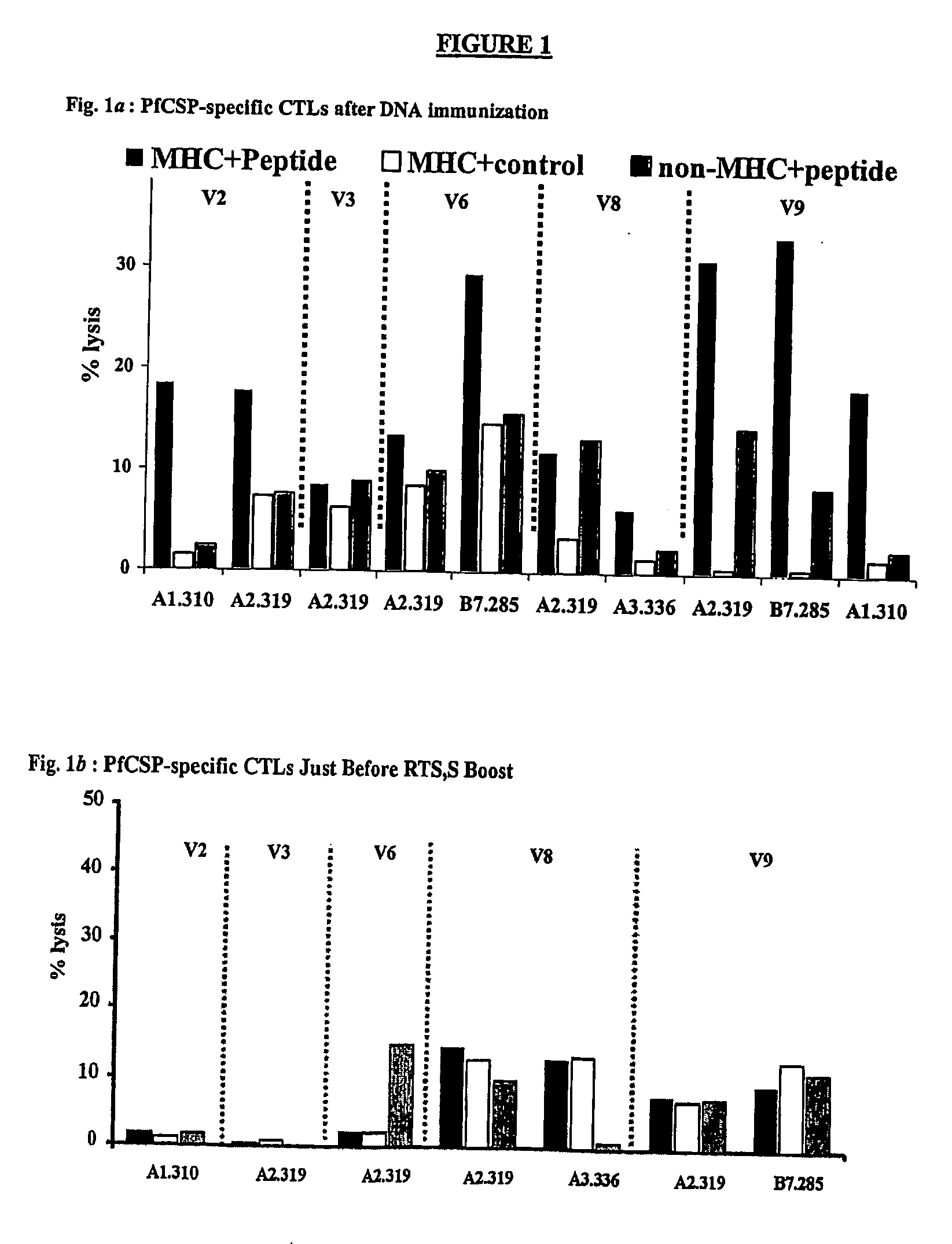Methods for vaccinating against malaria
- Summary
- Abstract
- Description
- Claims
- Application Information
AI Technical Summary
Benefits of technology
Problems solved by technology
Method used
Image
Examples
example 1
Boosting the Primed Anti-P / CSP Response with the RTS,S Vaccine
[0089] Twenty-four HLA-A*0201-positive volunteers were recruited for this study. The HLA diversity of the volunteers was restricted to the most common HLA Class I sub-type in this population in order to permit intergroup comparisons of genetically restricted T cell responses. None of these volunteers were previously exposed to malaria. Of these 24 individuals, 10 participated in the second PfCSP vaccine clinical trial described above. During that trial, these volunteers had received a total of three doses of the PfCSP DNA vaccine (VCL-2510, manufactured by Vical, Inc (San Diego, Calif.) as described previously (62)), given as 2500 μg per dose at 4-week intervals (62). Thus, in this trial, these 10 volunteers received their last dose of the DNA vaccine 12 to 14 months prior to receiving the boosting RTS,S vaccine. The remaining fourteen volunteers had not previously received the PfCSP DNA vaccine and were thus used as non...
example 2
CTL Responses
[0094] As discussed above, immunization with the RTS,S vaccine alone induces antibody and CD4+ T cell-dependent IFN-γ responses in humans, but has not been reported to elicit antigen-specific CTLs in humans (61). To determine whether DNA-induced memory CTLs could be recalled by boosting with the RTS,S vaccine and whether the boosted response was broader than the original DNA primed response, the cytotoxic activity of antigen-specific CTLs in different volunteers was assessed. Peripheral blood mononuclear cells (PBMCs) were collected from the blood of DNA-primed or non-primed volunteers 1-2 weeks before immunization with RTS,S, and 1 or 2 weeks after the first and / or second doses of RTS,S. These PBMCs were then used in a chromium release assay, which detects the lysis of antigen-presenting target cells (105).
[0095] The in vitro chromium release assays were performed as previously described (105). Specifically, to generate effector cells, 20% of the total PBMCs were inf...
example 3
T Cell IFN-γ Responses to PfCSP
[0104] IFN-γ responses were evaluated by standard ELISPOT assays as follows. The number of PfCSP-specific IFN-γ-producing cells was determined by ELISPOT after 36 h in vitro stimulation in the presence of 10 μg / ml of peptides as previously described (107). The number of spots corresponding to cytokine producing cells in wells (spot forming cells; SFCs) were enumerated with an automated spot counting system (Scanalytics, Fairfax, Va.). Responses were expressed as the mean number of SFCs / 106 PBMCs, and were considered significant if 1) the mean number of cells in wells with experimental peptide was significantly greater (p<0.05, student's T test) than in wells with control peptide; 2) the net SFCs / well (mean SFCs in experimental peptide wells minus the mean SFCs in control peptide wells) was ≧5 SFCs / well; and 3) stimulation index (the ratio of mean SFCs in experimental peptide wells to mean SFCs in control peptide wells) was greater than 2.0. Furthermor...
PUM
| Property | Measurement | Unit |
|---|---|---|
| Time | aaaaa | aaaaa |
| Mass | aaaaa | aaaaa |
| Mass | aaaaa | aaaaa |
Abstract
Description
Claims
Application Information
 Login to View More
Login to View More - R&D
- Intellectual Property
- Life Sciences
- Materials
- Tech Scout
- Unparalleled Data Quality
- Higher Quality Content
- 60% Fewer Hallucinations
Browse by: Latest US Patents, China's latest patents, Technical Efficacy Thesaurus, Application Domain, Technology Topic, Popular Technical Reports.
© 2025 PatSnap. All rights reserved.Legal|Privacy policy|Modern Slavery Act Transparency Statement|Sitemap|About US| Contact US: help@patsnap.com



